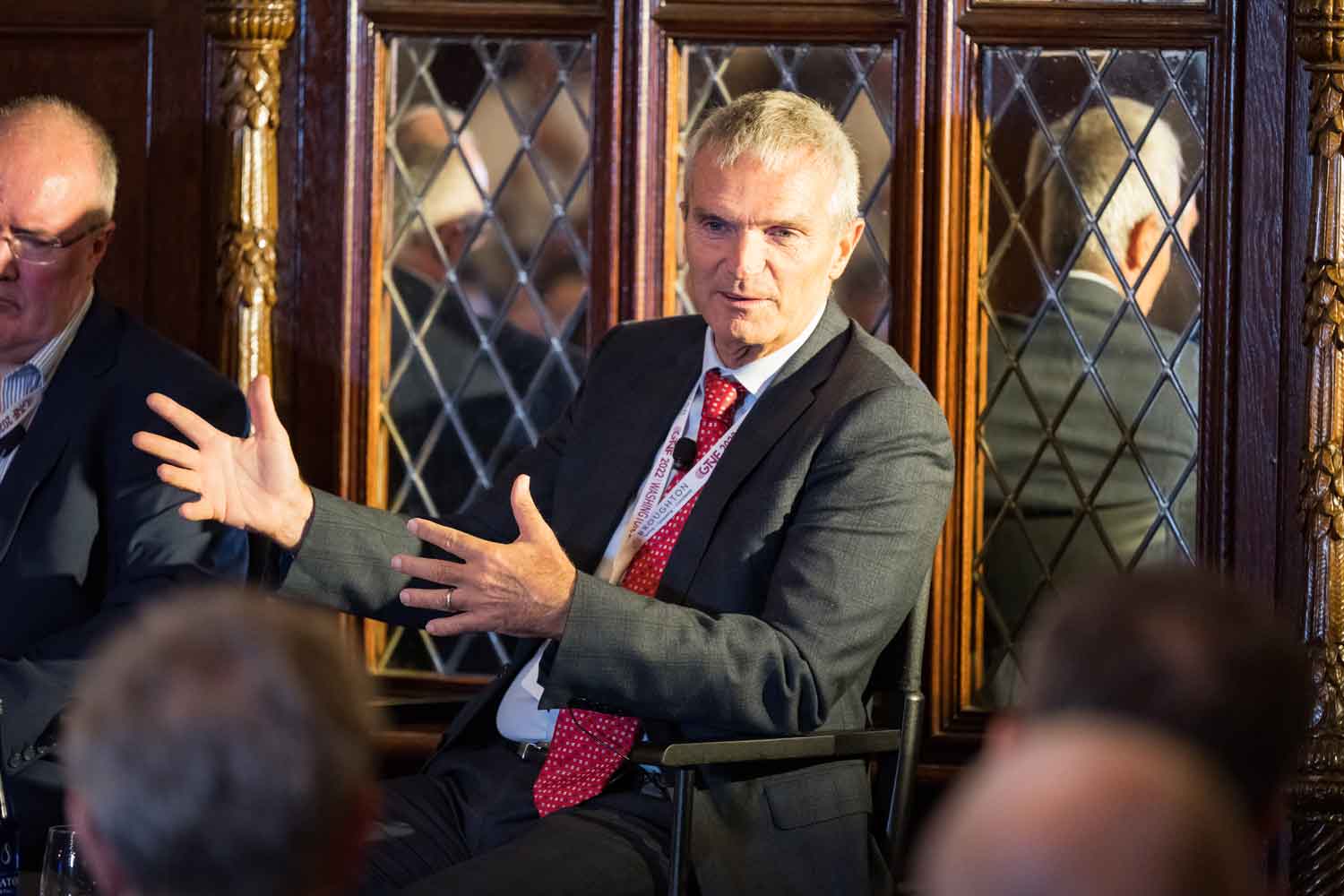Focus on Harm Reduction
- GTNF In Focus: News This Week
- April 26, 2023
- 26 minutes read
Credit: Red Pixel
Experts share their insights relating to tobacco harm reduction during the April 25 In Focus webinar
In the run-up to the 10th Conference of the Parties to the Framework Convention on Tobacco Control in Panama (COP10) this November, public health professionals, industry representatives and policy experts on April 25 shared their insights into issues relating to tobacco harm reduction (THR) and sustainability as part of the GTNF’s IN FOCUS online series. Following is a summary of the presentations and panel discussions.
Contributed


James Murphy, director of research and science at BAT, opened by saying that tobacco harm reduction is simple in concept: the switching of people who wish to use nicotine from risky forms of combustible tobacco products to lower risk tobacco and nicotine products. He noted that THR was the reason he joined the industry as a scientist almost 20 years ago, and that motivation remains today as the principal driver for coming to work each morning. His focus is making THR the centerpiece for all of BAT’s scientific research efforts.
Murphy outlined that the challenges to THR are many, but they are outweighed by the opportunities for reducing the health impact of the industry across the globe if stakeholders get it right. He sets out four key topic areas for his remarks: 1) the benefits of THR for reducing the impact of the industry on global public health; 2) the key challenges facing THR; 3) the need for a common view on the race to zero combustion; and 4) the importance of science.
Murphy stated that adult smokers who wish to continue to use nicotine now have access to a range of reduced-risk products that are better for them and for those around them. In countries that have embraced the concept of THR, including Sweden, the U.K., Japan and the U.S., there have been significant declines in smoking rates as smokers have migrated to noncombustible products, such as heated-tobacco products, vapor products and oral nicotine and tobacco products. Real-world evidence continues to be collected that indicates improvements in quality of life and lower instances of smoking-related morbidity when noncombustible products displace cigarettes.
Murphy gave an overview of upcoming opportunities for THR to be discussed globally, including the U.K. government’s upcoming publication of a new tobacco control plan, the COP10 meeting in Panama, the recommendations from the Reagan-Udall Foundation’s evaluation of the U.S. Food and Drug Administration’s Center for Tobacco Products, and proposals in 2024 from the EU around the third Tobacco Products Directive (TPD).
He set out four key challenges on THR: 1) objective science remaining at the core of the debate, with agreed frameworks for all stakeholders on assessing the risk profile of noncombustibles; 2) ensuring each country offers consumer access to regulated noncombustibles; 3) regulations must be enforced to prevent unregulated black market products being sold to consumers; and 4) preventing youth access to nicotine products and balancing the debate with the benefits of adult smokers switching to lower risk products.
Murphy then turned to the importance of the race to zero combustion, setting out the relative harm reductions (90 percent to 95 percent less) from heated-tobacco, vapor and oral products as compared to combustibles. Consumers using lower risk noncombustible tobacco and nicotine products experience substantially lower levels of toxins, comparable to levels observed in those who quit using tobacco products altogether.
He focused on the need for the industry to codify what is meant by THR: a race to zero combustion, not zero nicotine use, and reducing cigarette prevalence to below 5 percent, the accepted threshold for effectively zero in a country. He highlighted Sweden, which, through the use of snus and oral tobacco products, will achieve its smoking target 16 years ahead of the EU and has the lowest smoking-related disease outcomes anywhere in the EU.
He then turned to the importance of world-class science in providing a robust evidence base to substantiate the role of reduced-risk products (RRPs) in global THR. Regulators need it to form the basis of regulation; politicians need it so they can cut through the rhetoric; and consumers need it so they can feel confident in switching to lower risk products. He remarked that industry science is necessary as regulators require specific data on the manufactured products, as seen in the U.S. with premarket tobacco product application (PMTA) regulations or in the EU with the TPD.
Murphy closed by lamenting the polarization of the global debate on THR and the lack of scientific conferences where all stakeholders—industry included—can debate scientific studies and come to common conclusions on THR science to drive progress forward. His final remarks highlighted that the race to zero combustion has only really begun and that common science conclusions must form the basis of what the industry does.

Riccardo Polosa, professor of internal medicine at the University of Catania and founder of the Center of Excellence for the Acceleration of Harm Reduction, began his remarks by stating that there is no doubt that the evidence in favor of e-cigarettes being effective in terms of smoking substitution is quite strong. He highlighted the systematic reviews, randomized control trials and population studies that show evidence that e-cigarettes are important tools in helping smokers quit.
Turning to heated-tobacco products (HTPs), Polosa explained that it is true that HTPs are similar to e-cigarettes in that they deliver nicotine in an equivalent range and mimic the ritualistic aspects of cigarettes, and both have a potential for smoking substitution. Although there is population evidence to suggest that HTPs are effective in this, to date, there have been no real randomized controlled trials that have proved these assumptions.
He set out that researchers at the Center of Excellence for the Acceleration of Harm Reduction (CoEHAR) had designed and conducted a study to directly compare e-cigarettes with HTPs, involving the first randomized controlled trial of HTPs, in order to compare the effectiveness, tolerability and acceptability of both HTPs and refillable e-cigarettes for the purposes of cigarette substitution. The design of the study was standard: a switching trial, involving the randomization of 220 smokers not intending to quit but interested in trying new technologies and tar-free products. These 220 random subjects were split across two different products: IQOS 2.4 for HTPs and Justfog Q16 for e-cigarettes.
Polosa highlighted that the results showed clearly that the efficacy in terms of smoking substitution for HTPs is impressive, demonstrating how HTPs can help smokers to quit, with a continuous abstinence rate of 39 percent for HTPs versus 30.8 percent for e-cigarettes. He also showed that the number of dual users reduced over time, with the number of quitters increasing over time, and commented that this is a trajectory not normally seen in conventional smoking cessation trials.
Looking at risk perception, Polosa stated that there was no difference between the two groups: People using e-cigarettes perceive conventional tobacco as fairly high risk whereas they do not perceive their smoke-free product to be as risky as tobacco or conventional cigarettes. He also highlighted that both groups showed a clear improvement in terms of exercise tolerance over time, with results apparent even in week 4 of the trial, very early after switching.
He concluded by answering the question of whether HTPs are successful: yes.

The next speaker, Delon Human, president of Health Diplomats, started by quoting the definition of Article 1d of the World Health Organization Framework Convention on Tobacco Control (FCTC) and highlighted the phrase “harm reduction strategies” (HRS). He went on to set out that the overall goal of population health is to prevent disease and premature death, but it is important to remember that these are individuals with different needs and lifestyles. It is also important to include health professionals in any discussion on HRS to balance the needs of populations and individual health as well as the rights of individuals to access healthcare and to use nicotine products.
He stated that he wanted to make three suggestions to accelerate THR.
The No. 1 issue for Human is engagement. A whole-of-society and whole-of-government approach, involving multi-stakeholder action, is required, and more needs to be done with key stakeholders in the tobacco and nicotine industries, particularly regarding engagement with the WHO and governments. He continued by saying that Article 5.3 of the FCTC does not exclude engagement between industry and government; complex problems can only be solved with multi-stakeholder engagement, and engagement does not mean agreement. This engagement with industry is needed to facilitate the crucial exchange of knowledge and data.
Turning to his second suggestion, Human made the point about the centrality of science in the debate. The “quit or die” approach is ineffective, irresponsible and disrespectful of patients and consumers. They need to hear the full story and have access to information and products that do not involve combustion, specifically reduced-risk alternatives if they cannot or will not quit.
He highlighted that this transformation can be accelerated if global public health scientists were to embrace the opportunity to test the benefits of adult smokers switching to reduced-risk products. Human commented that, for too long, the argument has been that there is not enough evidence to validate THR in smoking cessation. HRS have been used successfully with HIV/AIDs, drug control and alcohol consumption, and they should be applied to tobacco control. He raised the speed of Covid vaccine testing, which gave a powerful validation of HRS.
Human spoke to the opportunity presented by COP10 to prepare the ground for further research in HRS and the new evidence available from countries where governments have allowed properly regulated reduced-risk products. Where THR has been adopted, smoking rates have reduced.
He gave examples: In Sweden, the smoking rate is the lowest in the EU at 5.6 percent whereas Germany has seen rates increase to up to 36 percent. He lamented that “smoke-free Sweden” should be a case study in successful THR, but little attention has been paid to the public health revolution there. In the U.K., the government’s “swap to stop” scheme has both incentivized and funded adult smokers to switch from combustibles to vaping, and more broadly, the country has seen a 4.3 percent decrease in smoking. In Japan, heat-not-burn (HnB) products launched in 2014 and have led to a significant decline in smoking rates: Between 2016 and 2019, the number of adult smokers fell by 10 percent. In the U.S., nicotine products go through a rigorous and scientific PMTA-testing process, which costs hundreds of millions of dollars to companies, and other countries could benefit from this knowledge to support their adult smokers to quit.
He closed this section of his remarks by suggesting that each example merits a country case study to consider how each THR approach has reduced incidence of smoking-related diseases and premature deaths, and more engagement among the WHO, governments and the whole of industry would facilitate progress in THR.
Lastly, Human turned to industry contributions to the debate, highlighting the critical role played by the GTNF in bringing stakeholders together. He highlighted several dimensions that merit industry having a seat at the table: 1) R&D capacity, with companies investing greatly in this, including specific knowledge on consumer behavior; 2) product innovation, with all stakeholders needing to incentivize innovation while ensuring consumer safety and high standards; and 3) responsible marketing practices, with the marketing to children of primary concern.
In closing, Human stated that there are 100 million consumers worldwide who have switched from combustible cigarettes to noncombustible nicotine alternatives, and now is the time to accelerate, transform and modernize tobacco control by injecting HRS, ensuring that affordable, accessible and acceptable alternatives can make a contribution.
Following his remarks, Human moderated a panel discussion titled “Using the FCTC to Accelerate Tobacco Harm Reduction” that included the following panelists: Grant Churchill, tutor in medicine at New College Oxford and associate professor in chemical pharmacology at the University of Oxford; Ehsan Latif, senior vice president of grants management and health and science strategy at the Foundation for a Smoke-Free World; Mihaela Raescu, professor in the faculty of dental medicine at Titu Maiorescu University in Bucharest; and Heino Stoever, social scientist and professor of social scientific addiction research at the Frankfurt University of Applied Sciences in Germany.
Human referenced the positive work done around the work in the harm reduction space, specifically citing Sweden, the U.K. and Japan as world-leading in this field. He spoke of Sweden’s incredibly low smoking rates with only 5.6 percent of the population using combustible tobacco.
He explained that the success seen in these countries needs to be examined in greater detail to highlight why vapes in the U.K., snus in Sweden and heated tobacco in Japan are increasing in popularity.
Human then detailed how several of his patients have seen remarkable improvements in their taste, smell and respiration since switching from combustible tobacco to RRPs in only two weeks.
Churchill tailored his contribution around the misconception of nicotine. He emphasized that tobacco, specifically combustible tobacco, needs to be separated from nicotine. He set out the molecular level of nicotine as a compound and explained that nicotine is not harmful in the concentration it exists within RRPs.
Churchill outlined that tobacco is made up of 4,000 smaller compounds, many of which are harmful. Nicotine represents only one of those 4,000 compounds and is not nearly as damaging as most of the others found in tobacco. For that reason, the education and rebranding of nicotine is critical in establishing RRPs as safe alternatives to combustible tobacco.
Latif spoke primarily from the regulatory perspective of the panel and led the conversation about the upcoming COP10 summit hosted in Panama later this year. He expressed his concern over a lack of action and not wanting legislators to make rash decisions. He called for all decisions to be led by facts and science, explaining that no RRP category should ever be prohibited as it will only lead to illicit trade and unregulated, untested products.
Latif echoed the message from Churchill that combustible tobacco is causing the most harm within the industry and that legislators need to take action to reduce the number of smokers. He emphasized this by saying, “You can’t wait 10 [years] to 15 years and then count the bodies at the end … We need some action now.”
Raescu explained the oral health benefits of switching from combustible tobacco to RRPs, describing how oral health improves drastically within nine months of making the switch. She mentioned that there is a decrease in bacterial plague concentration and quality, resulting in major oral health improvement.
Raescu also called for improved education for doctors and other health practitioners regarding nicotine and tobacco. She set out her belief that, currently, a lot of misinformation and misunderstanding results in the wrong advice for patients, having a negative effect on their individual health. Nicotine as a compound must be better understood by medical practitioners in order for it to be correctly conveyed to legislators.
Stoever started by giving a summary of the focus of his career on harm reduction in Germany. Using his experiences from Covid-19 and other emergencies, Stoever emphasized the importance of education and the lack of this in Germany: 60 percent of Germans think the dangers of vaping equate to those of tobacco. Stoever went on to set out that public health agencies in Germany are not providing adequate information on the benefits of reduced-risk products, and this gap has had to be filled by academics.
He spoke to the changes observed during the pandemic, where people’s lifestyle patterns changed radically to include working from home: There was an increased observance of people smoking during virtual meetings, which demonstrated the effectiveness of normal structural prevention strategies and social controls on preventing smoking besides behavioral prevention.

The panel discussion was followed by a keynote presentation by Mary Glindon, Member of Parliament for North Tyneside in the U.K. and vice chair of the All-Party Parliamentary Group (APPG) for Vaping.
Glindon set out her role at the APPG and the reasons for her interest in the topic of tobacco harm reduction. She spoke about her late husband’s transformation from smoking to vaping—his “pipe”—and the impact more widely that smoking has on her constituents in the northeast of England. Not only does she hear from those who have switched that their health has improved but also their finances, given the lower costs of vaping.
She spoke of her support for the U.K.’s ambition to be smoke-free by 2030 and the work undertaken by the Office for Health Improvement and Disparities (previously Public Health England) since 2015 to support vaping as a key harm reduction strategy, with it being proven to be at least 95 percent less harmful. Going further, Glindon praised the U.K.’s approach—one that she described as world leading and evidence led—with e-cigarettes at the heart of its strategy. She also highlighted the independent review last year by Javed Khan into “making smoking obsolete,” which included support for vaping as one of his key recommendations.
However, Glindon then spoke of the concerns Khan had also raised in his report that the U.K. will miss its 2030 target if it does not accelerate the rate of smoking decline by at least 40 percent.
She gave a series of recommendations on what action the government should take to remedy this while being clear that the preference is that people should neither smoke nor vape, nor should nonsmokers take up vaping. She spoke of tobacco harm reduction through vaping in the U.K. being consumer led but that it had left more than 6 million people who had not yet made the switch. Ensuring access to the right information and tackling misinformation and misperceptions of the relative harms of e-cigarettes versus combustible tobacco is key and must be embedded in all approaches on tobacco harm reduction.
Glindon also stated the need for effective communication strategies from governments, approved and trusted independent health messaging and the inclusion of the benefits of switching on vape packaging and on cigarette packaging too. She raised the need to ensure that medical professionals at local stop smoking services are sufficiently supported to speak authoritatively on reduced-risk products, with clinicians signposted to the latest clinical guidance and evidence on e-cigarettes.
Covering the recent announcements by Minister for Public Health Neil O’Brien, Glindon called for the U.K. government to finally release its new tobacco control plan and the new tobacco and related products regulations, both of which are two years overdue. She called for responsible companies like those represented at the GTNF to call out the bad actors who are undermining progress on tobacco harm reduction and for the industry as a whole to prevent youth access, tackle illegal products and promote sustainability.
Turning to the world stage, Glindon highlighted pressures from outside the U.K., including alternative policy directions from the EU and World Customs Organization on tariffs and taxes. Going further, she spoke to the upcoming COP10 conference in Panama later this year, calling it “the biggest threat to the U.K.’s world-beating harm reduction strategy” with its “singular mission focused on actively encouraging countries to ban vaping as part of its tobacco control approach, purposefully flouting the evidence of vaping’s success.” She called on the U.K. government to show leadership, to send ministers as part of the delegation to COP10 and to “actively take part in leading the conversation instead of only being a passive observer and financial contributor.”
Glindon then expanded on her concerns around preventing youth access, tackling illegal and noncompliant products and ensuring that the issue of sustainability, particularly with disposable devices, is addressed. She also called for an update on the vaping evidence set out by Public Health England back in 2015, asking how to get to a certainty greater than 95 percent less harmful.
In her closing remarks, Glindon spoke of the need to expand beyond a focus in the U.K. solely on vaping as a tool for tobacco harm reduction and called for the government to consider HnB and oral nicotine products to help reach the remaining 6.6 million smokers in the U.K. She emphasized the need for more research to be done, independent of commercial interests.
Finally, Glindon made clear that the industry has to address the key issues it faces—rogue players, youth access and environmental concerns—otherwise it faces being regulated out of existence. Her final words were “Be good: work hard, tackle the problems, seize the future.”

Global health advocate Derek Yach opened by stating how the world’s health is in a much worse state since coming out of the Covid-19 pandemic, particularly regarding noncommunicable diseases (cancers, cardiovascular diseases, diabetes and chronic lung illnesses) as well as mental health.
He used his own experience in the field of noncommunicable diseases to explain how different approaches must be taken, highlighting his concerns that what worked 20 years ago will no longer work in today’s climate and that modern science and health have to receive political and private sector support.
He then introduced tobacco harm reduction as a critical category that can help to reduce the growing concerns in this area. Yach spoke to the point that governments around the world are being inactive to, or even dismissive of, the clear and obvious benefits of RRPs. This is risking the health and lives of many of its own citizens.
Yach gave his own recommendations on how governments should address the 1.1 billion global combustible tobacco smokers still in existence today, referencing the positive work being conducted in the U.K., specifically mentioning the recent review by Javed Khan and the U.K. government’s recently introduced “swap to stop” scheme, which will offer 1 million vape starter kits to current smokers.
He made a call for the WHO and other governing bodies to appoint a commission that could 1) further develop the science and evidence now available; 2) review the progress of the U.K. and FDA in authorizing this positive change; and 3) take stock of the current situation and set it out in front of COP10 in Panama in November.
He then outlined the importance of the role of physicians and the need for them to be properly educated to understand the difference between tobacco and nicotine and between cigarettes and e-cigarettes. Without this education, medical professionals are unable to prescribe other, less harmful solutions to their patients.
Next, Yach spoke of the importance of COP10, urging delegates to showcase positive examples of how RRPs are used around the world to radically reduce the number of combustible tobacco smokers. Sweden, the U.K., South Korea and Japan were all offered as examples of how RRPs have been deployed correctly to help users make the switch away from cigarettes.
Finally, Yach held a mirror to the tobacco industry, commenting that it, too, was in need of further analysis of its own practices. He explained that in many low-income and middle-income nations, RRPs are legally available; however, the industry has not launched or given easy access to the range of harm reduction products available.
To this point, the major focus on RRPs has been in high-income countries, and there needs to be an acceleration of getting these products to all countries around the world.
Yach concluded his remarks by reflecting on his opening comments: Tobacco harm reduction is about stopping the growing trend of noncommunicable diseases and saving lives.
Yach then went on to lead a discussion panel titled “Drawing on Behavioral and Consumer Insights to Encourage Harm Reduction,” which included the following panelists: Jessica Zdinak, social and behavioral scientist and owner at Applied Research and Analysis Consulting; Mohamadi Sarkar, scientific strategy and analysis and regulatory affairs at Altria Client Services; and Cother Hajat, public health physician and epidemiologist at Independent Respondent.
Yach identified several smokers across the world attempting to quit smoking and asked panelists to consider what approaches should be adopted to help them do so. In many of the deprived communities of the world, Yach mentioned that availability of tobacco harm reduction products is an issue in order to get people to quit and tasked the panel to come up with solutions to remedy that.
Yach lamented the disinformation surrounding the e-cigarette or vaping product use-associated lung injury crisis that appeared in many academic research papers, which can still be found on the internet despite retractions being made by a research journal. He suggested that inspiration could be found from Twitter to ensure that such articles can be traced in order to issue a warning and correction relating to the disinformation.
Sarkar focused on the personal dimension that needs to be adopted by each of the 1 billion smokers around the world who need to stop smoking and shared his memories of treating smokers with diseases, such as myocardial infarction, when he was a clinician, but who ultimately did not quit.
Sarkar’s main concern is that disinformation has become a significant barrier to smokers quitting, with 80 percent of Americans in 2021 believing, wrongly, that e-cigarettes are as harmful as, if not more harmful than, combustible cigarettes. He also lamented that 80 percent of doctors surveyed believed that nicotine causes cancer.
Zdinak criticized the public health profession generally for omitting the basics of psychology and physiology in their appraisal of harm reduction efforts. She asserted that smokers’ basic needs must be met to successfully get consumers to switch to alternative products that are less harmful.
She went on to say that health communication messages should capture what people are thinking and feeling. In doing so, Zdinak referred to Maslow’s hierarchy of needs and where smoking cessation sits within smokers’ priorities and said that community groups may be necessary to create a higher order for them to consider quitting.
Hajat stated that the voices of smokers are often missing from research reports and reinforced the need to change that. She praised the U.K. Department of Health for embracing tobacco harm reduction products as vital weapons in its arsenal to improve the health of the nation and welcomed recent proposals to use pack inserts in combustible cigarettes.
She also welcomed the incentives for pregnant women, who make up 10 percent of the smoking population, and for people on low incomes to receive starter kits to accelerate smoking cessation and meet the government’s 2030 target to become smoke-free.

The panel discussion was followed by a keynote presentation from Jeremy Lim, CEO and co-founder of AMiLi. Lim opened by reflecting on the themes developed throughout today’s conference. He started by reaffirming the words of Yach, echoing his sentiment about the polarization of tobacco control and a lack of understanding of the differences between combustible tobacco and other nicotine products. He made clear that this is essential for countries in the developing world, which are chronically short of doctors, making misinformation even more problematic.
He supported the concept of introducing a WHO commission that specifically analyzes the positive progress made in countries like Sweden, the U.K. and Japan, which could result in a homogenized view of tobacco harm reduction, eradicating the misunderstanding about tobacco and reduced-risk products.
Lim then reemphasized what Sarkar had set out, explaining that much of the focus and attention is around theoretical concerns, such as youth access and environmental impact, but not enough spotlight is given to the individual smokers themselves who suffer the greatest impact from their addiction. He spoke of a systemic bias against smokers, citing the perception that smoking is a self-inflicted issue where subtle blame is given to the individuals who smoke. Smoking is not seen as a mental health or social health issue—it is seen as a choice.
Offering his own thoughts on the role society plays in helping or hindering the progress of tobacco harm reduction, Lim used the analogy of a person pushing a large cylinder up a steep hill. The gradient of that hill is determined by society—the more society hampers harm reduction, the harder it will be for people to quit; vice versa, the more society embraces the concept, the more support each smoker is given to quit.
Lim outlined his concern over the rising cases of youth access to vaping products, calling for a joint effort from everyone involved in the industry to remove these “bad players.”
He concluded his remarks by urging the industry to put its ideological and political preferences aside and to focus on science and on individual smokers instead.
